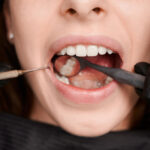Oral diseases can affect anyone, regardless of age or gender. Understanding the causes, symptoms, and treatments of common oral diseases is crucial for maintaining good oral health.
Tooth Decay (Cavities)
Tooth decay, also known as cavities, is one of the most prevalent oral diseases worldwide. It is caused by bacteria that produce acids, which damage the tooth enamel. Without proper treatment, cavities can progress and lead to toothache, infection, and even tooth loss. Prevention involves maintaining good oral hygiene, reducing sugar intake, and regular dental check-ups for early detection and treatment.

Gingivitis
Gingivitis is inflammation of the gums, usually caused by poor oral hygiene. Plaque buildup along the gumline can lead to irritation and inflammation, resulting in red, swollen, and bleeding gums. If left untreated, gingivitis can progress to periodontitis, a more severe form of gum disease that can cause irreversible damage to the gums and underlying bone. Treatment for gingivitis includes professional dental cleanings, improved oral hygiene practices, and in severe cases, antibiotic therapy.
Periodontitis
Periodontitis is a chronic inflammatory condition that affects the supporting structures of the teeth, including the gums and bone. It is characterized by deep pockets between the teeth and gums, gum recession, and bone loss. Periodontitis is usually preceded by gingivitis and is often caused by untreated plaque and tartar buildup. Treatment may involve scaling and root planing to remove plaque and tartar, antibiotic therapy, and in advanced cases, surgical interventions such as flap surgery or bone grafting.

Oral Cancer
Oral cancer can affect any part of the mouth, including the lips, tongue, cheeks, floor of the mouth, hard and soft palate, sinuses, and throat. Tobacco use, heavy alcohol consumption, and human papillomavirus (HPV) infection are significant risk factors for oral cancer. Symptoms may include persistent mouth sores, lumps or thickening in the mouth or throat, difficulty chewing or swallowing, and changes in voice. Early detection through regular dental check-ups and self-examinations is crucial for successful treatment. Treatment options for oral cancer may include surgery, radiation therapy, chemotherapy, or a combination of these treatments.
Prevention and Treatment
Preventing oral diseases involves maintaining good oral hygiene practices, such as brushing twice a day with fluoride toothpaste, flossing daily, and using an antimicrobial mouthwash. A balanced diet rich in fruits and vegetables and low in sugary and acidic foods can also help protect against tooth decay and gum disease. Regular dental check-ups and cleanings are essential for early detection and treatment of oral diseases. If you experience any symptoms of oral disease, such as toothache, bleeding gums, or oral sores that do not heal, it is important to consult a dentist as soon as possible for proper evaluation and treatment.




Pingback: Understanding and Treating Dental Abscesses: A Guide - Dental Healty
Pingback: Choosing the Right Implant Specialist: What to Pay Attention to - Dental Healty
Pingback: Understanding and Treatment Methods for Gum Diseases - Dental Healty
Pingback: Fluoride Treatments: 5 Benefits and Risks You Should Know - Dental Healty